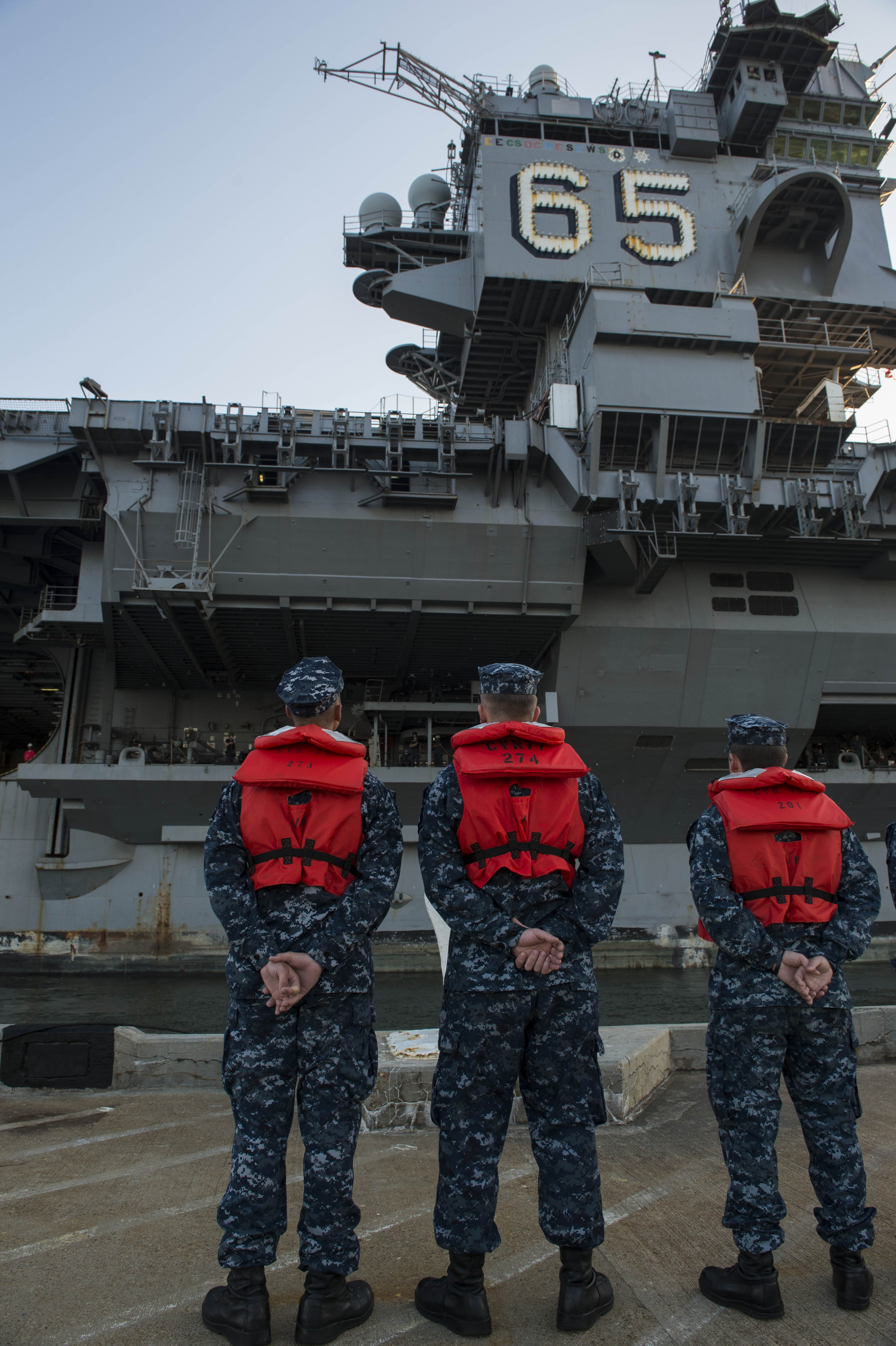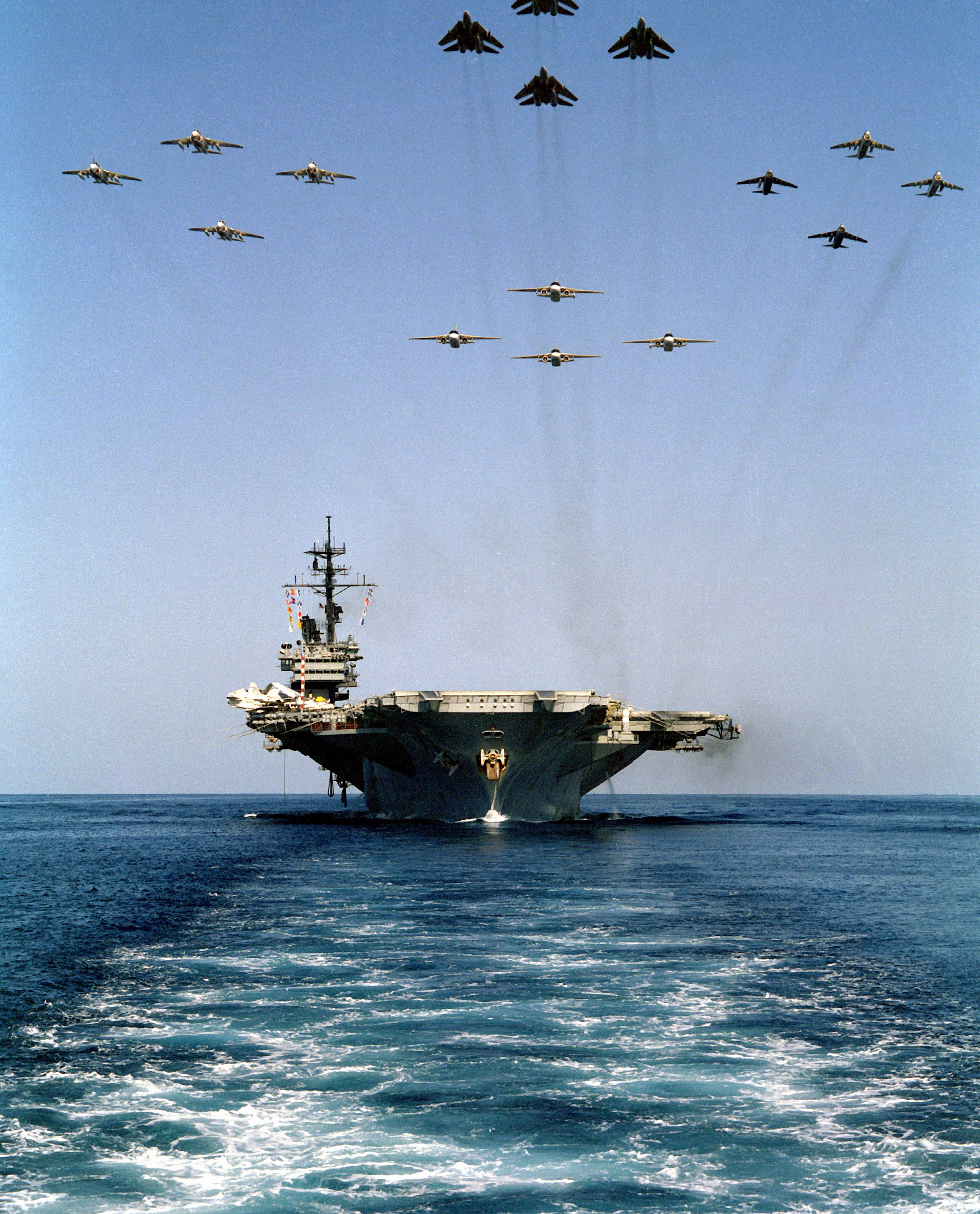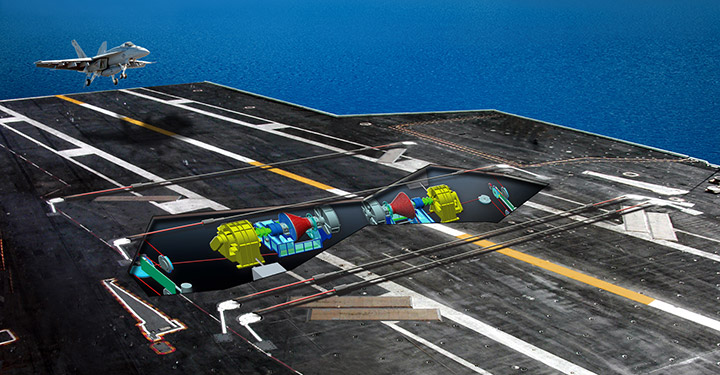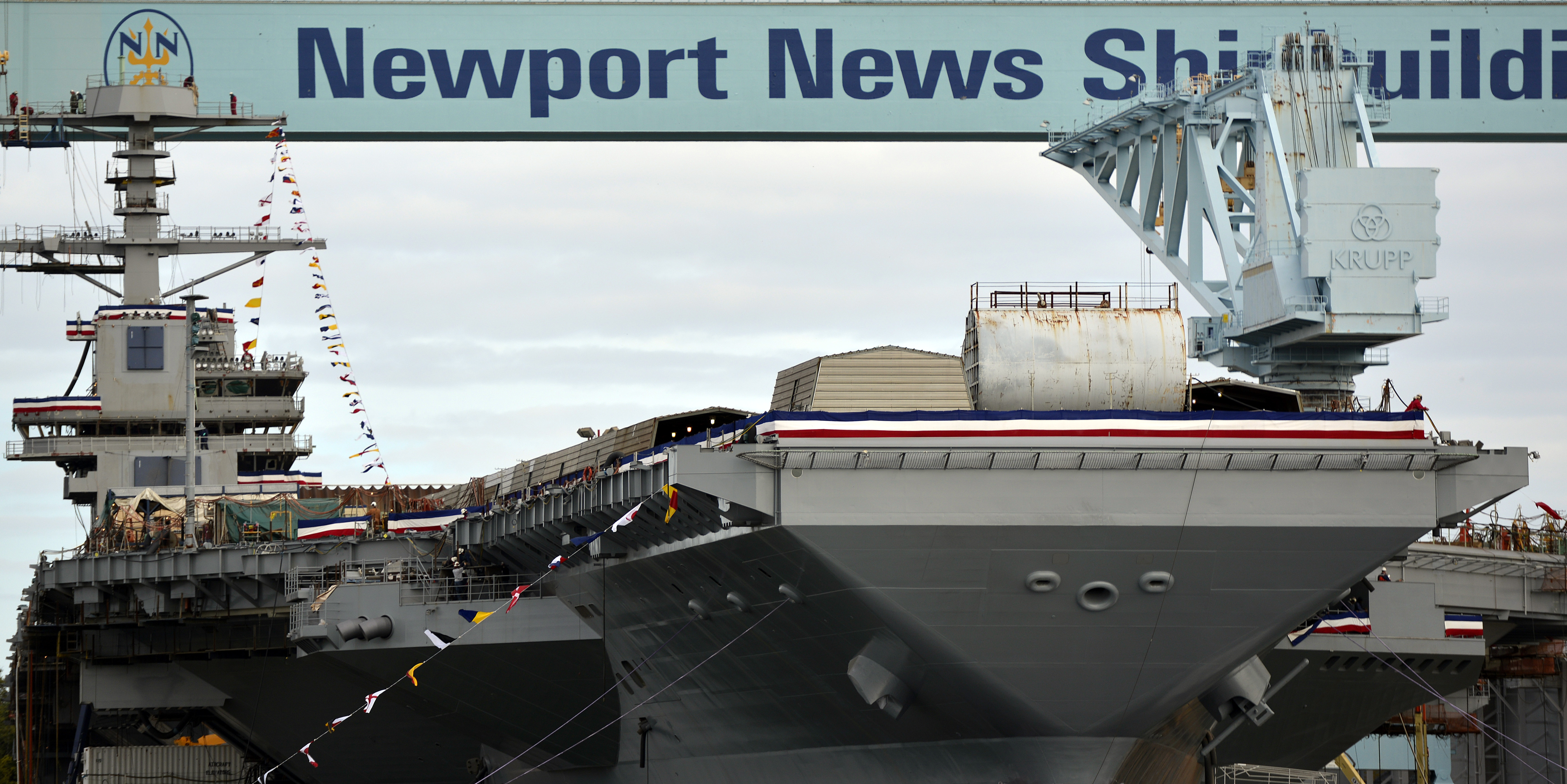The U.S. Navy is struggling with an undersized fleet, and is being pushed to its breaking point. The facts are clear. The carrier force is below the mandate required by law. Our ships are going on deployments of ever increasing lengths, all longer than planned—as long as 10 months. Because of backlogs of ship maintenance, unplanned repairs are popping up with increasing frequency stretching out the ships’ repair periods. Training periods are now being cut by three-fourths of their planned time.
Vital areas like the Mediterranean Sea and the Persian Gulf are being gapped of the presence of an aircraft carrier for the first time in decades. The Navy’s expected ability to surge three more carrier battle groups to a conflict will not be achievable by 2020 unless congressional budget uncertainty and sequestration cuts to readiness are fixed now. And finally, the newest aircraft carrier, USS Gerald R. Ford (CVN-78), will be kept from deploying for perhaps as long as four years for excessive testing.
The bottom line is this: the Navy needs more carriers and ships, and they are needed in the Fleet soonest if the Navy is to meet the National Command Authority’s operational requirements.
After World War II, the United States massively de-mobilized its military forces, reducing the Navy’s carrier force from 24 to eight. But that was before the Soviet Union detonated its atomic bomb, cemented its subversion of Eastern Europe behind the Iron Curtain, and developed seemingly close communist ties with Mao’s China. To defend against that threat the National Security Council, led by Paul Nitze, who later became the Secretary of the Navy, issued its famous NSC-68 directive in April 1950, calling for a massive response from the free world against the communists’ aggressive actions. In response the Joint Chiefs set a 12-carrier force as its goal. Two months later, communist China invaded South Korea. The U.S. Navy responded by bringing back 10 mothballed Essex carriers that increased the force to 18 by the time of the cease-fire. Afterward, in 1953, the Joint Chiefs aimed for 15 carriers, a goal it maintained until 2000.
But 15 carriers were difficult to maintain. In 1992 budget pressures forced the U.S. Navy to decrease the force from 15 to 12 by 1998. In 2006 more financial constraints threatened to further reduce the number. Congress responded by putting a floor under the carrier force at 12, which was codified into law in U.S. Code Title 10, Section 6052. However, USS John F. Kennedy (CV-67), which was expected to stay in service until 2018, retired in 2007. Faced with continuing budgetary woes and no alternative, Congress cut the number to 11 in 2007.
Recent events show the wisdom of 12.

First, in 2013 USS Enterprise (CVN-65) retired after 52 years of service. Although the Ford should have replaced her to maintain the force at 11, the Department of Defense’s transformational changes to the carrier program delayed her delivery until 2016, so Congress waived the requirement of 11 reducing the force to 10 until the Ford enters the fleet.
Second, in 2014 after back-to-back deployments with just a three-month interlude, several serious problems with the U.S. Navy’s second oldest carrier, the Dwight D. Eisenhower (CVN-69), were found in the shipyard, requiring repairs that stretched her stay out for almost one more year. This forced the Navy to swap its entire schedule to the newer Harry S. Truman (CVN-75).
Third, at his recent confirmation hearing to become Chief of Naval Operations, Admiral John Richardson confirmed that the Navy would not have a carrier patrolling the Persian Gulf for several months later this year, and that the Navy can only surge one carrier strike group to a crisis now. To Senator Tim Kaine’s (D-VA) point that unless congressional budget uncertainty and sequestrations cuts to readiness are corrected now, the Navy wouldn’t be able to restore the surge capability back to the expected three strike groups by 2020, Admiral Richardson reluctantly agreed.
Fourth, less than a month later, Vice Admiral Michael Shoemaker, the commander of U.S. Naval Air Forces, confirmed the daisy-chain effect of one carrier’s problems on an undersized force by announcing that the upcoming training periods for the Truman, which had maintenance problems of its own—and probably the George H. W. Bush (CVN-77)— will be shortened considerably to just 40 days from the expected 154-day training cycle to meet their scheduled deployments.
We are failing with a force of 10. 11 are law, but having 12 would be much better.
Why Twelve?
Since World War II, the U.S. Navy has routinely deployed three carriers forward at the same time to provide a powerful presence to areas of potential conflict. If conflicts arise, the U.S. Navy can surge three more carriers from a group that has recently returned from deployment or from the three preparing for deployment, which makes it possible to muster as many as six. In recent times with a force of 12, we mustered four for Operation Enduring Freedom in 2001, and six for Iraqi Freedom in 2003.
Therefore, to deploy three at the same time all the time and surge as many as three more forward to muster up to six for a conflict—while letting the three deployable carriers remain behind to continue training or do repairs—we need at least nine deployable carriers. A tenth carrier can then be up “on the blocks” for a year in a dry-docking repair period, and the 11th can be out of service in the multi-year midlife refueling. A 12th carrier provides back up when something goes wrong.
A Problematic Test Schedule
To get the carrier force’s numbers back up, the Ford’s exceptionally long test plan can and should be questioned by Congress to get her into the Fleet and deployed as soon as possible. A simplified version of the proposed test plan to the Defense Department’s Office of Operational Test and Evaluation shows 29 underway periods or independent steaming events (ISEs) from 2016 through 2018 with time reserved through 2019 to possibly stretch the plan to 2020. That would be four years between commissioning and first deployment.
Enterprise, the first nuclear carrier, steamed to the Mediterranean and quickly returned to participate in the Cuban Missile Crisis in 1962, all within 12 months of commissioning. USS Nimitz (CVN-68), the first of its class, deployed within 11 months of commissioning, and the second of the class, Dwight D. Eisenhower, deployed within 14 months of commissioning. For all ten Nimitz-class carriers, the average was 21.5 months.

Despite having 20 ISEs with 19 carrier airwing carrier qualification periods in 2016 and 2017—more than any previous carrier— the Gerald R. Ford still won’t be ready for deployment in 2018, some 24 months after commissioning. Her proposed test schedule continues with nine more ISEs (numbers 21 through 29) until the end of 2018, with more time reserved well into late 2019, where the only focus appears to be more testing of new arresting gear and catapults. Why?
On March 3, 2011, the DOD issued Directive Type Memorandum 11-003, which mandated high reliability standards for military systems. According to Government Accountability Office report GAO-13-396, “Ford-class Carriers: Lead Ship Testing and Reliability Shortfalls Will Limit Initial Fleet Capabilities,” the minimum number of cycles needed to make the new advanced arresting gear contained on the ship “minimally reliable” is 335,000 by 2027. There is a similar minimum reliability goal of 315,000 cycles for the new electromagnetic catapult on board the Ford-class.
To put that number in perspective, consider this: The 400,000th arrested landing on board the Enterprise did not occur until May of 2011—nearly 50 years after her commissioning. Achieving the “minimally reliable” number of cycles cannot be done through a test program alone before entering service.
So what is the purpose of the Ford’s second cycle of operational tests? Are the nine ISEs scheduled for 2018 with nine airwing carrier qualification events meant to drive up the number of cycles on the new arresting gear and catapults by 10,000 cycles? Even that won’t get it very far to 300,000-plus cycles.
History of Innovation

With the exception of the new nuclear plant on the Nimitz, all the other critical carrier technologies or innovations were first developed and proven decades earlier on five classes: 13 Essex–class carriers, three Midways, four Forrestals, four Kitty Hawks, and the first nuclear-powered carrier, the Enterprise.
For example, in the U.S. Navy, the British innovation of the angled deck was first put on the Essex-class carrier Antietam (CV-36) in 1952 and then later improved with the addition of cable-suspended deck-edge elevators on the Forrestal class in 1954. The steam catapult was first put on the Essex–class carrier Hancock (CV-19) in 1954. The new optical-landing system that sends a light up the glide path to safely guide fast-approaching jets was first put on the Saratoga (CV-60), the second Forrestal-class carrier, in 1957.
But not all these technologies panned out. For example, the Enterprise’s SCANFAR system, the guided-missile program’s first attempt to put a phased-array radar on warships in the 1960s that gave the Big E’s island her unique boxy shape, was a failure and had to be replaced. It took another 22 years to successfully put the phased array radar to sea on the missile cruiser Ticonderoga (CG-41) in 1983 by the now-revered Aegis program.
This is very similar to the Ford’s phased array radar, the dual-band radar, whose development from the Navy’s DD-1000 truncated destroyer program produced only one set—the Ford’s. It will be replaced with the new Enterprise Air Surveillance Radar (EASR) on the new John F. Kennedy.
However, with 30 years and on 25 ships, it is obvious that those technologies successfully developed for carriers went through hundreds of thousands of cycles that made them reliable well before the Nimitz class came along.
For the DOD to then hoist those “300,000-plus cycles” as test requirements on the Ford’s advanced arresting gear and electromagnetic launching system in 2011 in the middle of their developments is unreasonable. There was no such opportunity for the Ford program to have its technologies’ reliability’s proven on older carriers. Moreover, the DOD changed the Navy’s chosen evolutionary three-ship approach to a “transformational” single-ship approach in which 12 new technologies are all developing within 20 years on only two ships.
How to Save Time

So how can the Navy deal with the systems (advanced arresting gear and the electromagnetic launching system) that will not have been cycled hundreds of thousand times? As safely as possible, that’s how. Already cycled hundreds—if not thousands—of times at the Naval Air Warfare Center in Lakehurst, New Jersey, they will be further tested on the ship to ensure proper installation. Then the Ford would go to sea for the next two years at least 20 times and test them vigorously until they are certified safe to use.
Once certified, they would be managed by the Navy’s Naval Aviation Safety Management Program (SMS), which would strictly specifies their certified configuration and safe envelopes of operations. As the systems are in service, SMS monitor’s their safe usage, and “ground” them when an unsafe operation was known or suspected by the fleet operators. SMS has provided the Navy with the safe use of hundreds of different types of aircraft and aviation systems as reasonably as can be expected since WWII, and it has been routinely and continuously improved. The Ford’s 20 at-sea test periods and two years of time should be enough to safely deploy them with these safe but “immature” systems.
However, the DOD just ordered the Navy to conduct shock trials on Ford that will further delay its first deployment. Shock trials are expected on new ships, but have yet to be done on the first ship of the class. The first nuclear-powered ship shock tested was the Arkansas (CGN-41), the fourth cruiser of the Virginia class, in 1982; the first carrier was the John F. Kennedy (CV-67), the fourth of the Kitty Hawk class, in 1984; the first nuclear-powered carrier was Theodore Roosevelt (CVN-71), the fourth of the Nimitz class, in 1986; the first nuclear-powered submarine was Jacksonville (SSN-699), the twelfth fast-attack submarine of the 688 class, in 1988; and the first Aegis guided-missile destroyer, USS John P. Jones (DDG-53), the third of the Arleigh Burke class, in 1994.
Ignoring those facts and the fact that the carrier force is below minimum and overstressed, the DOD still ordered the shock test on Ford. The Navy’s response is that it may further delay the Ford’s first deployment by two more years. However, if further testing is required, it shows that we are paying for the investment now, and it must not be wasted. Moreover, the extended stay of Eisenhower in the shipyard saved its fuel for another year and a later retirement in 2028. That provides an opportunity to build two more carriers within the next 10 years to restore the force back to 12.





